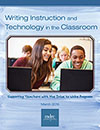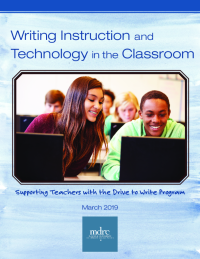Writing Instruction and Technology in the Classroom
Supporting Teachers with the Drive to Write Program

 Around the country, high school teachers are being called upon to improve student writing, but they often lack the tools and requisite know-how to make a difference. An ambitious new program called Drive to Write is attempting to change that. This report describes an evaluation of the program’s implementation in 11 public high schools in New York City during the 2017-2018 school year.
Around the country, high school teachers are being called upon to improve student writing, but they often lack the tools and requisite know-how to make a difference. An ambitious new program called Drive to Write is attempting to change that. This report describes an evaluation of the program’s implementation in 11 public high schools in New York City during the 2017-2018 school year.
Drive to Write involves expert coaches to help teachers use Google Suite tools for managing classroom assignments, providing actionable feedback to students, and using data to assess a student’s progress for the sake of differentiating, or customizing, instruction. The program was designed by New Visions for Public Schools, a support network in New York City that offers services such as professional development and data infrastructure to public schools. The intervention targets ninth grade Global History teachers who are not trained writing instructors. Their students are scheduled to take the Global History Regents Exam at the end of tenth grade — a prerequisite for graduation.
As of 2016, only 68 percent of students passed this exam. In June 2019, the test is likely to become even harder because of a new, rigorous essay requirement that accounts for almost one-third of the total score. The Drive to Write program focuses on this essay to help teachers advance student writing.
Key Findings
-
The program rolled out as intended throughout the 2017-2018 school year. Coaches tailored their feedback for teachers and helped them focus on writing instruction by using technology to support workflow and data to guide their approach to individual students.
-
Teachers customized their use of technology tools and writing instruction to suit the needs of their students and the constraints of their classroom. Nevertheless, practices related to writing and technology use among the 15 program teachers in the 11 Drive to Write schools were similar to those of the 17 teachers in 12 comparison schools. Teachers in program schools, however, exhibited greater understanding of, and proficiency with, higher-level writing instruction.
-
It is unclear whether the program had a positive effect on student writing after one academic year of implementation. The analytic sample included 1,008 program students and 936 comparison students. Several factors could have dampened early effects, such as comparable writing improvement among all students during ninth-grade, similar technology practices between program and comparison students, or a sample of schools too small to detect modest effects. It could also be that the assessment score outcome may reflect student skill at timed test taking (which all schools address), rather than the intervention’s core focus on intensive writing composition (on which program schools spent dedicated time).
This evaluation contributes to the growing literature that highlights the support teachers require to integrate new technology and data tools into their instructional routines, the role of individualized coaching for teachers, and the sustainability of data-driven teacher feedback to students. An understanding of these elements can lead to better implementation of writing programs in high schools across the country and, potentially, improved student writing.






